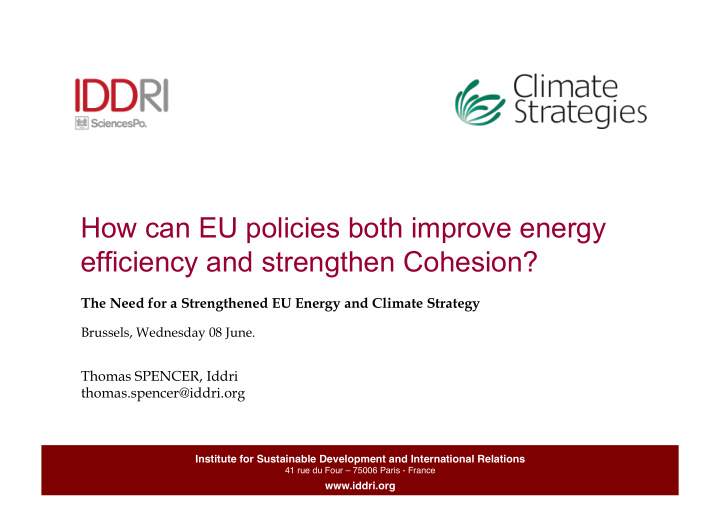



How can EU policies both improve energy efficiency and strengthen Cohesion? The Need for a Strengthened EU Energy and Climate Strategy Brussels, Wednesday 08 June. Thomas SPENCER, Iddri thomas.spencer@iddri.org Celine MARCY, IDDRI � Institute for Sustainable Development and International Relations � 41 rue du Four – 75006 Paris - France � www.iddri.org �
Energy Efficiency and Consumption Trends Fig 1: Energy efficiency index (ODEX) for final consumers Fig 2: Absolute final energy consumption by sector • The EU’s overall 20% energy savings target will not be met. • Buildings and transport are the weakest link in EU climate policy. 2
Policy recommendations 1. The EU should set binding targets, at the MS level, expressed in final energy, and in energy intensity, to improve the energy efficiency of the existing building stock, and complement these targets with a combination of obligations and incentives. 2. The EU should adopt new legislation incentivizing avoided transport and modal shift, through coordinated European transport infrastructure policies. 3
Focusing in on the New Member States (I) EU Cohesion policy is divided into three objectives: 1. Convergence, which aims to stimulate growth and employment in the least developed regions. 2. Regional competitiveness and employment, which aims to support regions’ competitiveness and attractiveness as well as employment, by anticipating economic and social changes. 3. European territorial cooperation, which aims to reinforce cooperation at the cross-border, transnational and interregional level. Preparing CEE economies to thrive in an energy and carbon constrained world would seem, prima facie , compatible with Cohesion policy objectives. 4
Focusing in on the New Member States (I): Energy efficiency Table 1: setting out the problematic Raise the threshold for energy efficiency in the ERDF (currently capped at 4%). Low-carbon labour force re-skilling via the ESF. Structure and co-finance domestic funding instruments via cooperation with EEEF 5
Focusing in on the New Member States (II): Transport Fig 3: Transport related cohesion policy allocations Fig 4: transport evolution, CEE and EU27 35,000 30,000 25,000 20,000 15,000 10,000 5,000 0 Incentivize modal shift and avoided transport via EU infrastructure policy Create a long-term framework to internalize transport externalities harmoniously across MS, fuels and modes. 6
Focusing in on the New Member States (II): Energy infrastructure Table 2: Grid investment needs CEE Fig 5: Technology priorities for grid operators There is a role for Cohesion/EU fiscal policy to invest in transnational infrastructure (heading 3/TEN-E) Cohesion policy should support pilot projects in the field of smart grids and ADM to build experience 7
Conclusions • There is a need to refocus on absolute energy consumption in key sectors; • … and prepare for the electrification of final energy consumption. • EU fiscal policy can play a key role here: auction revenues (MS level) and the EU Budget (EU level) • For the CEE MS key priorities include building efficiency; transport and energy infrastructure. • Ultimately, there may be synergies between the goals of Cohesion policy; CEE post-crisis growth strategies and climate policy 8
Recommend
More recommend